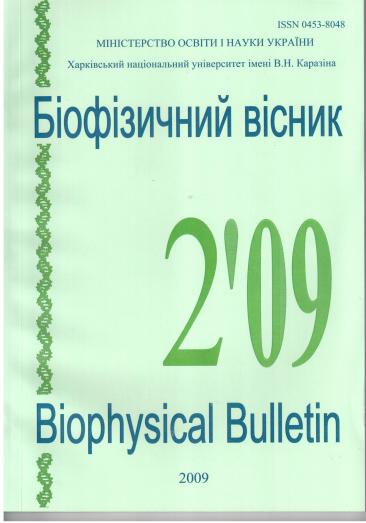Theoretical analysis of efficiency of rapid two-step freezing regimens
Abstract
On the basis of traditional concepts on phase transition kinetics during cooling of multi-component solutions
and transmembrane transfer of substances we developed the quantitative model of cryodamage of yeast-like
fungi Saccharomyces cerevisiae suspension in the cryoprotective solution in non-linear cooling regimens at its crystallization stage. The designed theoretical model is verified by the experiments, testifying to the adequacy of the proposed model concept about cryodamage of cells at the stage of cell suspension crystallization, in a particular solution of “dimethyl sulfoxide (10% v/v) – sodium chloride (0.135 M) – water” under exponential cooling regimen. The mechanism of the cryoprotective effect of rapid two-step cooling was shown to have no substantial differences from optimal from the point of view of the two-factor theory of cryodamage coolingegimen with a constant cooling rate. It is established that the optimal non-linear cooling regimen of yeast-like fungi cells Saccharomyces cerevisiae could be implemented by plunging of the container carrying the cell suspension into the liquid-cooled down to -35ºC for 20-25 minutes with following rapid cooling in liquid nitrogen.
Downloads
References
2. Гордиенко Е.А., Пушкарь Н.С. Физические основы низкотемпературного консервирования клеточных суспензий.-К.: Наукова думка, 1994.-144 с. (С.122-128).
3. Терентьев А.Н., Кадетов В.В., Богданова М.И., Цуцаева А.А., Высеканцев И.П., Милютин А.В. Влияние низких температур на жизнеспособность бактерий Y.Pestis EV76//Криобиология.- 1990.-№2.-С.52-53.
4. Mazur P., Schmidt J.J. Interactions of cooling velocity, temperature and warming velocity on the survival of frozen and thawed yeast//Cryobiology.-1968.-5, N1.-P. 1-17.
5. Mazur P. Theoretical and experimental effects of cooling and warming velocity on the survival of frozen and thawed cells //Cryobiology.-1966.-2.-P.181–192.
6. Mazur P. A two-factor hypothesis to freezing hamster tissue-culture cells/ P.Mazur, S.P.Leibo, E.H. Chu// Experim. Cell Research..- 1972.- V. 71, No 2.- P. 345-355.
7. Mazur P. Kinetics of water loss from cells at subzero temperatures and the likelihood of intracellular freezing//J. Gen. Physiol.- 1963.-47.-P.347–369.
8. Mazur P. Studies on rapidly frozen suspensions of yeast cells by differential thermal analysis and conductometry//Biophys. J.-1963.- 3.-P.343-347.
9. Mazur P. The role of intracellular freezing in the death of cells at supraoptimal rates/P. Mazur// Cryobiology.-1977.-V. 14, №2.-P.251-272.
10. Mazur P. Physical-chemical basis of injury from intracellular freezing in yeasts/Peter Mazur .- Sapporo: Hoccaido Univ. Press, 1967.-P. 171-189.
11. Mazur P, Pinn IL, Kleinhans FW. Intracellular ice formation in mouse oocytes subjected to interrupted rapid cooling//Cryobiology.- 2007.-V.55, №2.-P.158-166.
12. Mazur P. Freezing of living cells: mechanisms and implications// Am. J. Physiol. Cell Physiol. - 1984. - V.247, №3. - P.125-142.
13. Miller R.H. Survival of frozen thawed human red cells as a function of cooling and warming velocities/R.H. Miller, P. Mazur//Cryobiology.- 1976.- V/13, N4.- 404 – 414.
14. Mazur P. Cryopreservation of the Germplasm of Animals Used in Biological and Medical Research: Importance, Impact, Status, and Future Directions/ P.Mazur, S.P. Leibo, G.E. Seidel, Jr. //Biology of reproduction.- 2008.-V. 78.-.P.2–12.
15. Гордієнко Є.О., Гордієнко О.І., Марущенко В.В., Сакун О.В. Удосконалена модель пасивного масопереносу крізь плазматичну мембрану клітини // Біофізичний Вісник – 2008. – Вип. 21 (2). – С. 75 – 80.
Authors who publish with this journal agree to the following terms:
- Authors retain copyright and grant the journal right of first publication with the work simultaneously licensed under a Creative Commons Attribution License that allows others to share the work with an acknowledgement of the work's authorship and initial publication in this journal.
- Authors are able to enter into separate, additional contractual arrangements for the non-exclusive distribution of the journal's published version of the work (e.g., post it to an institutional repository or publish it in a book), with an acknowledgement of its initial publication in this journal.
- Authors are permitted and encouraged to post their work online (e.g., in institutional repositories or on their website) prior to and during the submission process, as it can lead to productive exchanges, as well as earlier and greater citation of published work (See The Effect of Open Access).





